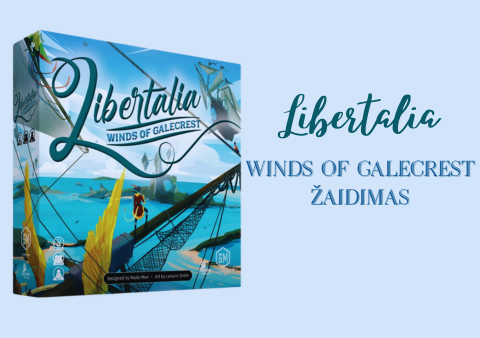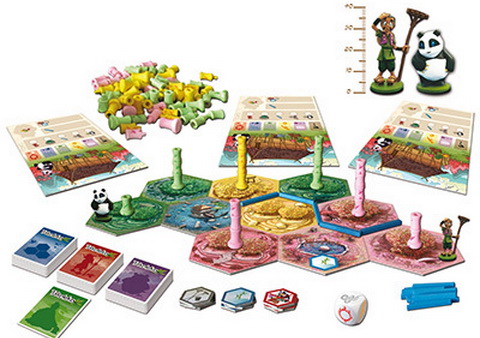The Azul board game is one of the more modern and popular games.
The game has a unique story and attracts thousands of players with its gameplay mechanics and design.
In this article, we will look at the features of Azul, its origins, type, number of players, age, length of play and difficulty level, pros and cons.
Key facts
| Created by | In 2017 |
| Game type | Strategic, Family |
| Number of players | 2-4 |
| Duration of the game | 30-45 minutes |
| Complexity | Medium |
| Age of players | 8+ |
| Indicative price | EUR 39-46 |
The aim of the game
The aim of the game is to carefully glue the tiles of the same pattern on the front wall in order to score as many points as possible.
Pluses and minuses
✅ Exclusive design: The patterns and colours of the tiles and the game components match each other perfectly and are of high quality.
✅ Simple rules: The rules are easy to understand, but some may find it difficult to grasp the strategy.
✅ Promotes communication: Encourages discussions in families or small gatherings of friends.
✅ Different game variations: This a board game can be played in several different variations, giving the game an extra twist.
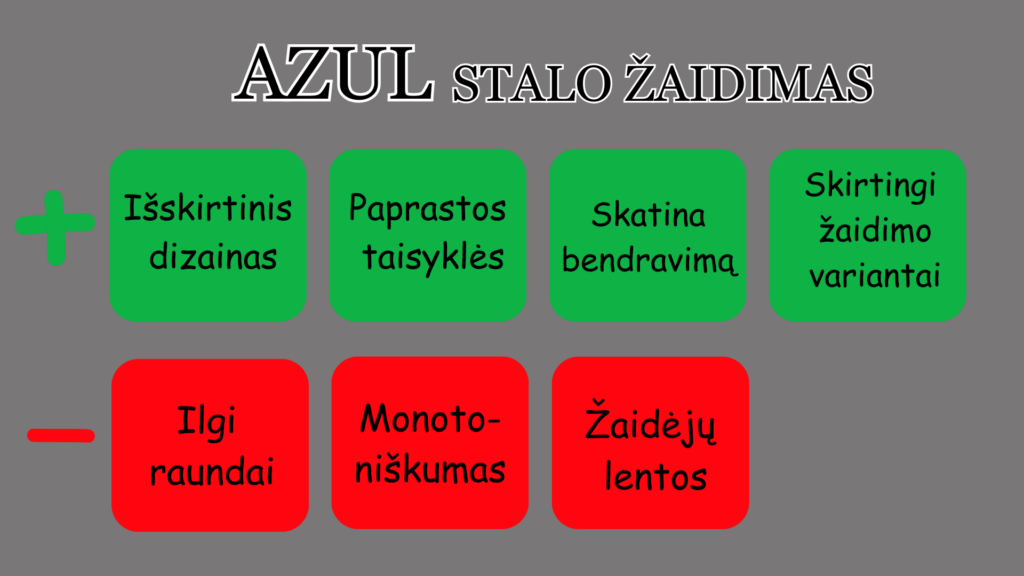
❌ Long rounds: Some parts of the game can take a long time, especially if you are playing with new players. This may not be acceptable for players who like short and intense games.
❌ Monotony: Longer rounds of the game may lack variation as the actions become monotonous.
❌ Player boards: Players' personal boards are slightly convex, so they may not lie flat on the table surface at the start.
Game rules
At the start of the game, players must choose which side of the game board they want to play on. It is recommended that new players play with the coloured side.

Circles of game tiles are placed in the middle of the table to "produce" tiles (factories).
Circles are placed on the table according to the number of players:
- Two - five,
- Trims - seven,
- Four have nine.
A beginner player is then selected by lot.
He receives a first player token and a bag of 100 tiles.
After mixing them well, place four on each circle.
The first player starts the game clockwise.
For example: he can take two tiles of the same colour from a circle and leave the different colours in the centre between the circles.
You must also take the first player's chip and place it in the bottom-left corner of your table.
Then, on his/her board, the player places the appropriate tiles from right to left in the designated rows of shelves to the left of the player's board.
This is how to arrange the tiles in the same pattern in the rows allocated to them, until there are no tiles left on the table.
Wall tiling
Consistently, from top to bottom, simultaneously, all players review their tile rows.
If there are full rows of tiles of the same colour, the player sticks the rightmost tile on the wall marker of the corresponding coloured tile, and puts the remaining tiles of that colour back into the bag.

Preparing for the next round
Players check to see if they have filled in their rows and if not, prepare for the next round.
If no player has filled the horizontal row, then the first player will fill the circles again with new tiles by pulling them from the bag.
If even one player completes, the game ends and the players count the points.
Calculation of victory points
If only the first row is filled in, the player gets only 1 point.
Second - 2 points, etc.
If the tiles pasted on the tiled wall intersect, the corresponding points are multiplied by the number of rows.
At the end of the round, the points of the tiles on the bottom left row are deducted - two tiles -2 points, three tiles -3 points, etc.
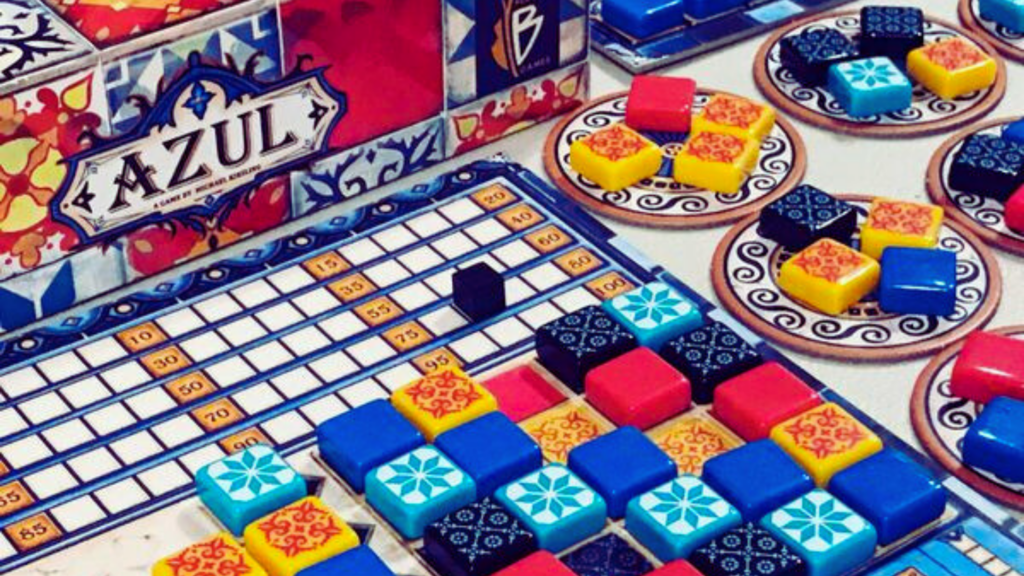
A separate scoring table in the bottom right corner of each player's board calculates victory points: horizontally, +2 points for a complete row, vertically +7 points, and +10 points for a complete colour.
Strategy and tactics
Azul is not a game of random luck, so strategy and tactics are key.
It makes sense to know how to play the game better:
- The right choice of colours and patterns should be made to match the stock of wall tiles to be bonded. This requires proper planning of your tiling locations and which rows are best to fill.
- You should always keep an eye on the situation on your board and the availability of tiles on the circles, and think at least a few moves ahead.
- You need to be flexible and plan well, as situations can change quickly, so it's best to have at least a few alternative plans in place and to adapt to the current circumstances.
- Avoid penalty points, which can reduce your chances of winning. It is therefore better to avoid the accumulation of tiles in the lower part of the table, where each tile receives -1 point. Therefore, every effort should be made to use all the tiles taken.
Second game option
For a slightly different game, players can flip their game board to a less colourful and more challenging version of the game.
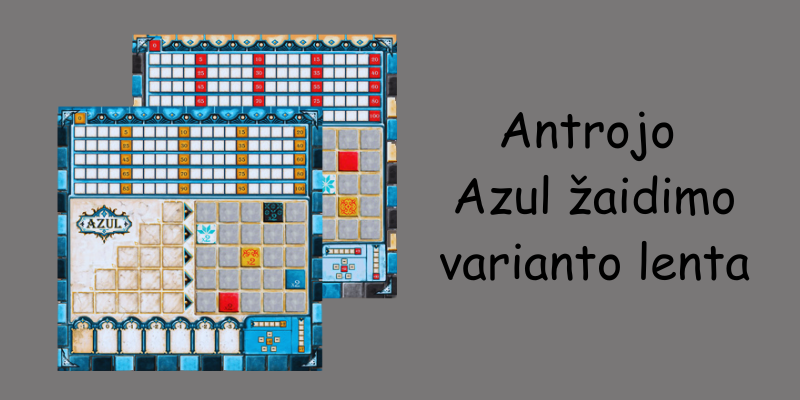
In this variation, players from the rows on the left can stick their tiles anywhere on the wall on the right, but there can be no tiles of the same colour on the same row, vertically or horizontally.
In the event of a discrepancy, the tiles are moved to the "minus" row in the bottom left corner of the board.
This is a more challenging variant of the game and is recommended for experienced players.
What is in the game kit?
Before starting the game, you need to familiarise yourself with all the necessary components. The game box includes:
| Player boards | 4 |
| Tiles in different colours and patterns | 100 |
| Markers | 5 |
| Circular factory tiles | 9 |
| First Player Tile | 1 |
| Sack | 1 |
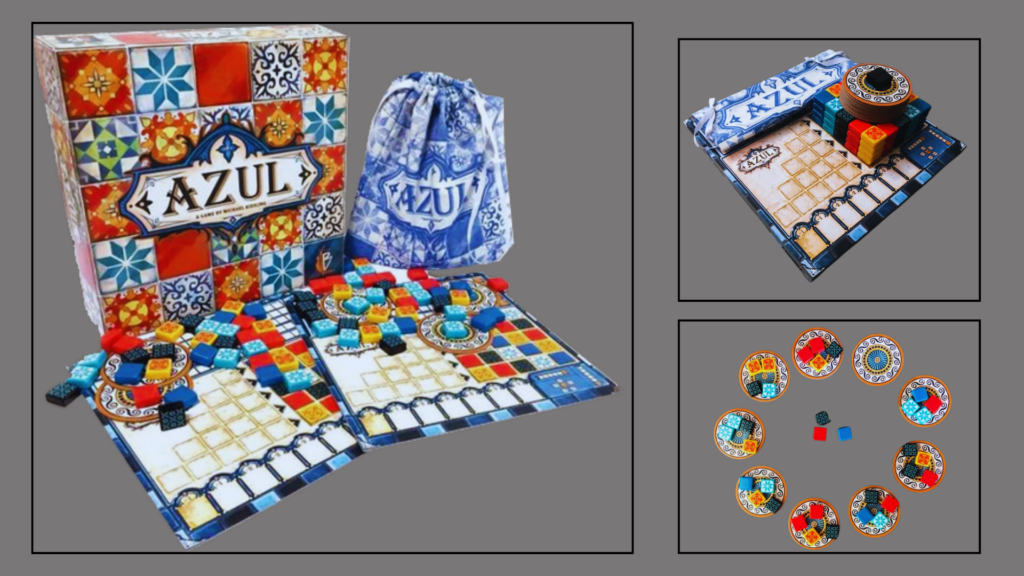
History
Azul was created in 2017 by Portuguese designer Michael Kiesling. This game was published by Game Company Plan B Games, in partnership with Next Move Games.
The board game Azul has become hugely popular, winning numerous awards (e.g. 2019 UK Games Expo Best Abstract Game People's Choice Winner) and being nominated for prestigious board game awards.
Azul board game - summary
The Azul board game is not only perfect for two players, but also for the whole family.
It impresses with its elegant and distinctive details, while the colours create a pleasing visual impression.
Azul has some subtleties in the rules, giving players room to experiment with their own solutions, making each game different.
What is the purpose of the Azul board game❓
The aim of the game is to carefully glue the tiles of the same pattern on the front wall in order to score as many points as possible.
What is the duration of the game❓
The game lasts about 30-45 minutes.
This board game is recommended for ages 18+❓
According to the rules, the game is intended for children over 8 years of age.
How many people can play this board game❓
The game is for 2-4 players.
What type of game❓
This board game is classified as a strategic, family game, but it is also suitable for parties or for playing with two people.
